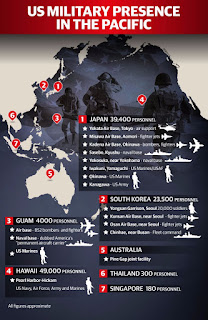How does US military power stack up against North Korea, China and Russia?
A nuclear-powered US aircraft carrier arrives in South Korea on March 15
Charis Chang, news.com.au
The diversion of US warships to North Korea is a show of American military power but how does the nation’s weapons capability stack up against others and can it continue to maintain its superiority?
While America is undoubtedly the “top dog” when it comes to its military, experts say North Korea could still land a massive blow against the US.
“Most pundits think that whatever happens in Korea, if somebody hits the button, the fighting would be very intense but brief and would lead to massive devastation,” Professor John Blaxland said.
Prof Blaxland is the acting head of the Strategic and Defence Studies Centre at the Australian National University and says while the US has superior weaponry, other countries such as North Korea, China and Russia have massive stockpiles of weapons and trained military to counteract this.
According to the Global Firepower website, which collates publicly available information about the military capability of different countries, America is ranked number one in terms of its war-making ability across land, sea and air.
“It has the most powerful military in the world without question,” Prof Blaxland said.
The US annual defence budget of $581 billion dwarfs China, which spends $155 billion, Russia on $45 billion and North Korea on $7.5 billion.
But if you look at how many soldiers America has access to, it’s a different story.
The US has an active military personnel of 1.4 million, and a reserve army of 1.1 million.
When it comes to soldiers based on the North Korean border, the US only has about 20,000 troops permanently stationed in South Korea, as well as about 8000 air force personnel and other special forces. There were also about 50,000 military personnel based in Japan.
Compare this to North Korea, which has 700,000 active soldiers, but a whopping 4.5 million reserves.
Prof Blaxland said North Korea had also massed about 20,000 rockets and missiles on the border with South Korea, and when you are playing a numbers game, technology doesn’t always win.
“There’s a saying ‘quantity has a quality all of its own’,” he said.
“North Korea has massed artillery and missile capability adjacent to the demilitarised zone, close to Seoul, which puts it in range of a population about the size of Australia — it’s pretty scary.”
Prof Blaxland said US troops stationed in South Korea could probably shoot down a large number of missiles but chances were, some would still get through.
“It doesn’t matter how good your technology is, if they get a few rounds off the ground, there will be mass casualties.”
“The problem is the quantity, just the sheer mass,” he said. “(Especially) if you aren’t that concerned about how many people die in the process, which Kim Jong-un isn’t.”
It has been estimated that in this scenario North Korea could potentially kill about 100,000 people.
So while North Korea may not ultimately win a war against America, it could certainly ensure many people also go down with it.
This could also be a problem with any matchup between the US and China or Russia.
All three countries have nuclear weapons but would not be motivated to use them as any retaliation would likely annihilate them as well.
Prof Blaxland said the Russians had massive firepower capability including ships, submarines and armed forces. Recently the Russians had demonstrated in Ukraine that they had the ability to bombard a 1km square area of land and “basically clean it out”.
“That is a frightening prospect,” he said.
He said China had put a lot of emphasis on its cyber technology, as well as copying western technology. It had long range munitions that could sink an aircraft carrier or knock down satellite systems the US relies on heavily.
While there was no question the US had the most powerful and technologically advanced military in the world, Prof Blaxland said no matter how good an aircraft was, if it was overwhelmed by dozens of enemy craft then “you’ll run out of ammo before they do”.
Another issue is that the US’s forces are dispersed across the world, with troops in Iraq, Afghanistan, Syria, as well as Europe, Latvia, Australia, Korea, Japan, Guam and Hawaii.
“The US is incredibly powerful militarily but if it takes on more than one big fight at a time, it’s probably biting off more than it can chew,” he said.
In the past, Prof Blaxland said America’s military was designed with the capability to fight two and a half “major theatre wars” at the same, but these days it is in a position where it could barely do one or maybe one and a half.
“Bearing in mind that they are already tied down in Afghanistan, Iraq and Syria, they are considerably constrained (to fight a major war),” he said.










No comments:
Post a Comment